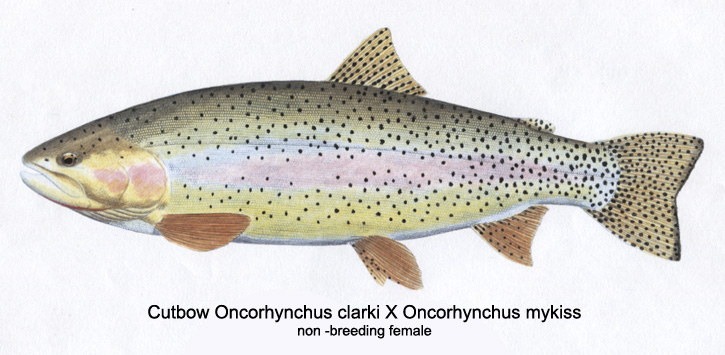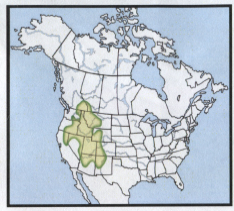Cutbow August 2011, Fish of the Month!
 Cutbow Trout
Cutbow Trout
Oncorhynchus clarki X Oncorhynchus mykiss
Local Names:
Cutbow
Average Size:
12 to 24 inches
1 to 8 pounds
Distinguishing Field Marks:
As a hybrid cross of the Cutthroat and Rainbow trout, the Cutbow shows characteristics of both lines. Individual specimens and “races” of Cutbow will have varying field marks, depending on light, water, and general habitat conditions. Consistent throughout though are the typical red or red-orange color slash on the near-bottom of the gill covers and jaws, and the usually broad pink or reddish band just below the lateral line. 
North American Range:
Map to the right shows approximate range in North America.
Diet:
Typical of stream and lake-dwelling western trout species, young Cutbows feed on all life-stages of aquatic and terrestrial insects and other aquatic invertebrates as they are available. The diet of adult Cutbows is increasingly made up of forage fish.
Fly Fishing for Cutbow:
Match your fly-rod outfits to the habitats you’ll be fishing, increasing in line weight as the size of the water increases. Four and Five weight for small streams and presenting small flies, up to six or even seven weight for larger rivers, ponds, and lakes and casting larger flies such as streamers and larger nymphs and wind-resistant dries.
Small tributary streams should be fished with match-the-hatch fly patterns on light lines and leaders. Muddlers, Stonefly, Caddisfly, Mayfly nymphs, wets and dries, and forage fish imitating streamers will attract larger trout in larger rivers, ponds, and lakes.
Cutbows may well take flies presented to what the angler assumes will be mostly native Cutthroats, which statement begs a discussion of this hybrid’s place in western trout waters. Simply put, through natural inter-breeding of species, Rainbows (and hatchery bred Cutbows) introduced into what were traditionally Cutthroat-only waters, are deeply diluting the pure Cutthroat gene pool and are “taking over” in many watersheds. To give them their due, Cutbows are excellent fly-rod fish, but, so are pure Cutthroats. Again, this Cutbow take-over is evidence of the possible harm that can be done to native species and their habitats through the introduction of non-native species. And still again, we recommend your reading Anders Halverson’s excellent and very “readable” book, An Entirely Synthetic Fish, Yale University Press, 2010, which chronicles the intentional introduction of (especially) Rainbow trout over much of the world’s Northern Hemisphere.






